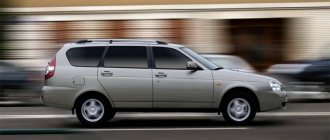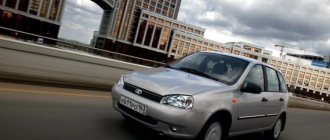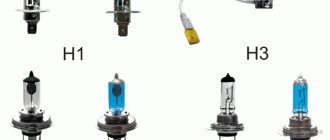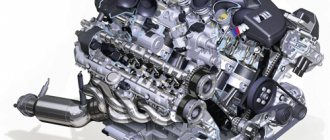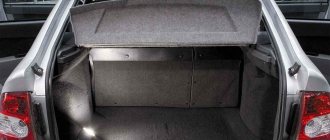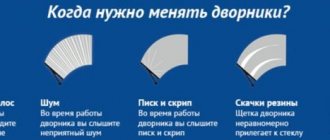Lada Priora became the successor of the VAZ-2110, adopting several elements from it and gaining the sympathy of domestic car owners - where would we be without cans. About 400 parts were redone. In its segment, Lada Priora receives one of the best ratings due to its unpretentiousness and good performance. But what exactly is worth saying about the car is that the technical characteristics of the Priora car are quite decent for its class.
AvtoVAZ introduced the VAZ-2170 model in the mid-2000s, Priora was produced from 2007 to 2022, and in 2013 it underwent restyling with minor changes. Over the years, a large number of VAZ cars have been produced, and many ideas have emerged to improve and stylize Lada Priora cars. Technical characteristics are the point at which an experienced driver chooses a car; you shouldn’t buy it for its pretty eyes. Although look at the picture below and her eyes. 
Performance characteristics of the Priora car engine: 126 and 127, how many horsepower and torque
The technical characteristics of the Priora car engine show 98 and 106 horsepower on board. This applies to engines with a displacement of 1.6 liters.
- Motor - 98 horsepower received number 21126. Maximum torque - 4000 rpm at 145 Nm.
- Motor - 106 horsepower is listed under number 21127, torque - 4,200 rpm at 148 km.
Motor 21127 is a modified version of the 126 model, but both of them are available with sixteen valves. In addition, the Priora has two eight-valve engines with a displacement of 1.6 liters, which produce 81 and 87 hp, but they are not as common as newer versions. Interestingly, there are engines with a volume of 1.8 liters.
- The first 1.8 liter engine produces 98 hp. (21127 also works), but the torque is 3000 rpm at 160 Nm.
- The 123 hp engine, which was installed on sports versions, produces 4000 rpm at 165 Nm.
Compared to the weight of the car, sixteen-valve engines are sufficient for free movement.
As for the technical condition, the VAZ-21126 and subsequent models are superior to eight-valve versions of engines, which is why car owners choose them more often. The most common “layout” is the Priora sedan with a 21126 engine and a manual transmission.
Recommendations for improvement
For the first time, it was decided to increase the power of the new Priora 21126 engine at the factory in order to create a sports modification of it. Camshafts with increased lift, a lightweight connecting rod and piston group were installed, and the intake and exhaust tracts were modified. This is how the first domestic sports unit appeared, which was put into production, and they began to install it on the Lada Granta Sport model.
The technical characteristics of the engine are as follows: engine power from the Priora has increased to 118 hp. torque - up to 154 Nm at 4700 rpm, fuel consumption also increased to 7.8 liters per 100 km with a combined driving cycle. We will give a number of recommendations on how to independently increase the power of Priora engines:
- The simplest and most affordable way is to install a zero-resistance exhaust tract. The essence of its work is to reduce the resistance of the path, as a result of which some of the power spent on overcoming this resistance will be released and become useful.
- The same operating principle applies to the zero-resistance intake tract. Installing the receiver and throttle body to 56 mm will allow the power unit to “breathe” more freely, and your Lada Priora will become several horsepower more powerful.
- Deeper tuning - new camshafts with a sports configuration, allowing the intake and exhaust valves to open more. This will give a noticeable increase in the agility of the car, especially in city conditions.
- Replacing the standard valves and connecting rod-piston group with a lightweight one will again release some of the useful energy of the unit and add it to the main power. Here you can kill two birds with one stone: install pistons with recesses, thereby eliminating the possibility of them “meeting” with the valves when the timing belt breaks.
- We should not forget about CHIP tuning. After major changes in the engine configuration, its operating mode will definitely improve, and in order to optimize it and adjust fuel consumption, you need to do a flashing.
Recommendations are given taking into account that the power plant is in good technical condition. If this is not the case, when tuning it is worth replacing worn parts and oil in order to get the desired effect from the changes. As a result of the above measures, the Lada Priora will receive an additional 20-30 hp. without reducing the resource.
How many horses can Priora have in addition to this? Quite a lot, there are capabilities and components to increase the power ultimately to 400 hp. This is due to a radical modification of the power plant: boring the cylinders, grinding the cylinder head, replacing the injectors and fuel pump with more efficient ones, installing four throttle valves and a turbocharger.
We should not forget about modernizing the brake system. Such tuning will give excellent results in terms of power, but the engine life will be significantly reduced, and fuel consumption, on the contrary, will increase significantly.
Characteristics (performance characteristics): Priora gearboxes
Priora is equipped with two gearboxes:
- mechanical;
- robotic.
The five-speed manual transmission is always stable. The owner’s task is to monitor it and give it proper care, without relying on the car to “fix itself.” The gear ratios are such that they make the car with six-valve engines reach “hundreds” in just 11 seconds.
The robotic automatic transmission also comes with five speeds. It is a slight modification of the old reliable Japanese Jatco box. According to AvtoVAZ, it is not inferior in acceleration to cars with manual transmission. Errors such as kicks during overclocking may occur. They can be removed by reprogramming the ECU. The clutch is a dry single-plate clutch with a diaphragm pressure spring inside. The clutch release drive is cable with automatic adjustment.
Rules for long-term use
Surely every Priora owner wants to operate his car without unnecessary unexpected costs and is thinking about how to increase the car’s service life. To do this you need to follow a few simple rules:
- The power unit of the VAZ 2170, even without various improvements, has sufficient potential for “spirited” driving. But in order to save it and extend its life, such driving should be avoided. Smooth acceleration and maintaining a stable speed not only on the highway, but also in the city will help extend the life of the engine and save fuel and your own money. The maximum permissible speed on the highway should be no higher than 120 km/h, the optimal speed is 100-110 km/h, and it is important to maintain stability.
- It is important to timely replace consumables, that is, oils in units, filters, spark plugs, high voltage wires, generator and timing belts, and coolant. The interval between engine oil changes depends on its quality and chemical base. Mineral-based oils should be changed more often, synthetic oils less often. You should never determine the quality of motor oil by its color. If it has acquired a black tint, this does not mean that the oil is bad - it means that an excessive amount of combustion product deposits is formed in the engine. First of all, you need to find the source of the carbon deposits and eliminate it, and then change the oil.
- The new engine must be properly broken in, and then the oil must be changed, following the manufacturer's instructions. When running in, avoid increased loads, sudden movements of the accelerator pedal, and do not exceed the speed specified in the instructions.
- Always monitor the engine coolant temperature, check the operation of the electric cooling fan, thermostat and temperature sensor. Overheating is the main enemy of the piston group; every time the temperature is exceeded, it wears out intensely, and the life of the unit is sharply reduced.
“Lada Priora” is a modern high-speed domestic car that will bring its owner a lot of positive impressions and driving pleasure, provided that the engine is cared for and properly modified and operated.
Body dimensions and weight of the Lada Priora car - hatchback, station wagon, sedan, coupe, long
The ideal car is different for everyone - it all depends on why they are buying it. Priora is perfect for both the younger generation and the older. The weight that it can lift varies - for example, the station wagon received a voluminous trunk that can accommodate more things. The width of the Priora remains unchanged - exactly 164 cm. The weight of the car ranges from 1578 to 1598 kg.
Hatchback
When it comes to overall dimensions, the Lada Priora cannot but rejoice - you can drive with it even in the narrowest yard. The curb weight of the hatchback is 1163 kg, the maximum permissible is 1578 kg. The trunk volume is 360 liters, and with the seats folded down – 705 liters. Height is 143.5 cm, length – 421 cm.
Sedan
The dimensions of the sedan are slightly different, but the weight of the car remains the same. The trunk volume is 430 liters. The sedan body dimensions are 142 cm in height, length is 435 cm.
Station wagon
The improved technical characteristics of the Lada Priora station wagon allow you to seriously load the trunk - they took care of the reinforced suspension in advance. Unlike the hatchback, the station wagon has a length of 13 cm longer - 434 cm. The height is 150.8 cm. The trunk volume is 444 liters and 777 liters with the seats folded down. The total weight can be equal to 1598 kg.
Coupe
The three-door hatchback Lada Priora was produced in a sports version and featured improved characteristics - after restyling, there were 123 horses under its hood. The body elements had to be redone, which did not affect the dimensions so much. Length is 424.3 cm, height 143.5 cm.
Long body
The extended Priora is the Premier version, premium. Its base was lengthened by 17.5 cm, the rear door was made larger, and an additional section was added to the glass. Under the hood there is a noticeable advantage - more “horses” are needed to pull a heavier car. The salon is decorated elegantly and stylishly. The width remains the same - 168 cm, the length is 452.5 cm, and the height is 142 cm. The curb weight is 1100 kg, and the trunk volume remains the same - 430 liters.
Suspension characteristics
The Priora's chassis was designed for smooth driving over bumps and obstacles, as well as driving along a country road. Of course, the VAZ-2170 is not an SUV, but it can easily go through many places. The front part of the suspension is independent, and the rear part is semi-independent, which makes the car softer.
Many owners almost immediately replace the anti-roll bar arms along with the struts with a sports kit - so that the car does not wobble when making a sharp turn. Telescopic shock absorbers consistently dampen vibrations when passing obstacles, so there will be no problems with it. VAZ-2170 is a front-wheel drive car.
- Front suspension is MacPherson type with longitudinal braces.
- The rear suspension is also with trailing arms. It has a U-shaped transverse beam, to which a torsion-type anti-roll bar is attached.
As for the ground clearance, for the pre-restyling version it was 165 mm, and for the restyled version it was 170 mm. The wheelbase is 249.2 cm, the front track width is 141 cm, the rear track is 138 cm. The suspension can be lowered or raised if desired - ready-made kits for modernization are available for open sale.
Technical characteristics of Lada Priora
The production of the restyled LADA Priora (“Lada Priora”) began in November 2013. The following cars of this family roll off the assembly line of JSC AVTOVAZ: VAZ-2170 - with a sedan body, VAZ-2171 - with a station wagon body, VAZ-2172 - with a body hatchback (five-door and three-door). The cars can be equipped with two four-cylinder sixteen-valve engines with a volume of 1596 cm3 and a power of 98 and 106 hp. Toxicity standards comply with Euro-4 standard. The cars are equipped with a five-speed manual transmission with front-wheel drive.
The updated LADA Priora meets modern requirements for passive safety. The front and rear bumpers are made of impact-resistant material to absorb impact energy during a collision. The B-pillars, roof and sills are reinforced. Metal reinforcements are installed in all doors to improve resistance to side impacts.
The information is relevant for Priora models 2013, 2014, 2015, 2016, 2017, 2022 model years.
| dimensions |
The basic equipment of the car includes: a tilt-adjustable steering column, power windows for the front doors, a driver's airbag, and electrically adjustable exterior mirrors. The car's headlights can operate as daytime running lights, which do not blind drivers in the oncoming lane and significantly reduce energy consumption.
To better meet customer needs, the vehicle is equipped with various options. These include: front passenger airbag, front seat belt pretensioners, anti-lock brakes (ABS), electronic stability control (ESC), cruise control, air conditioning, power windows on all doors, power mirrors, modern multimedia system, on-board computer , automatic windshield wiper control, automatic exterior lighting control, turn signals in the side mirrors, fog lights, heated windshield.
LADA Priora is a compact, economical car, well adapted to the conditions of our climate and the characteristics of Russian roads.
| Total information | ||||
| Body type | Sedan | Station wagon | Hatchback, 5-door | Hatchback, 3-door |
| Number of doors | 4 | 5 | 5 | 3 |
| Number of seats (with rear seat folded) | 5 (2) | |||
| Curb weight, kg | 1055-1110 | |||
| Permitted maximum weight, kg | 1578 | 1593 | 1578 | 1578 |
| Permissible total weight of the towed trailer, kg: | ||||
| equipped with brakes | 800 | |||
| not equipped with brakes | 500 | |||
| Trunk volume (5/2 seats), l | 430 | 444/777 | 360/705 | — |
| Maximum speed (engine 21126/21127), km/h | 183/186 | |||
| Acceleration time to 100 km/h (engine 21126/21127), s | 11,5/10,5 | |||
| Fuel consumption (engine 21126/21127), l/100 km: combined cycle | 6,9/ 6,8 | |||
| Fuel tank capacity, l | 44 | |||
| Engine | ||
| Model | 21126 | 21127 |
| engine's type | Gasoline, in-line, four-stroke, four-cylinder | |
| Location | Front, transverse | |
| Valve mechanism | DOHC, 16 valves | |
| Cylinder diameter x piston stroke, mm | 82.0 x 75.6 | |
| Working volume, cm3 | 1596 | |
| Rated power, kW (hp) | 72 (98) | 78 (106) |
| at engine crankshaft speed, min-1 | 5600 | 5800 |
| Maximum torque, Nm | 145 | 148 |
| at engine crankshaft speed, min-1 | 4000 | 4200 |
| Supply system | Multiport fuel injection | Distributed fuel injection. Variable length of intake manifold channels |
| Fuel | Unleaded gasoline with an octane rating of at least 95 | |
| Ignition system | Electronic, part of the engine management system | |
| Toxicity standards | Euro 4 | |
| Transmission | |
| Clutch | Single disc, dry, with diaphragm pressure spring |
| Clutch release drive | Cable, with automatic adjustment of cable length |
| Gearbox type | Mechanical, five-speed, with synchronizers in all forward gears |
| Drive wheels | Shafts with constant velocity joints |
| Chassis | |
| Front suspension | Independent, MacPherson type, with telescopic shock absorbers, coil springs, wishbones, longitudinal braces and anti-roll bar |
| Rear suspension | Semi-independent, with coil springs, telescopic hydraulic shock absorbers and trailing arms connected by a U-shaped transverse beam and a torsion-type anti-roll bar built into it |
| Wheels | Disc, steel or light alloy (spare wheel - steel) |
| Wheel size | 5.0Jx14H2; 5.5Jx14H2; 6.0Jx14H2; PCD 4×98; DIA 58.6; ET 35 |
| Tires | Radial, tubeless |
| Tire size | 175/65R14; 185/60R14; 185/65R14 |
| Steering | |
| Steering gear | Variable ratio rack and pinion |
| Power steering | Electric - mounted on the steering shaft |
| Steering gear | Two rods with rubber-metal joints (on the steering mechanism side) and ball joints (on the swing arm side) |
| Brake system | |
| Service brake system | Hydraulic, dual-circuit - diagonal, with vacuum booster (can be equipped with ABS) |
| Front wheel brake | Disc, ventilated with single-piston floating caliper and automatic adjustment of the gap between the disc and pads |
| Rear wheel brake | Drum-type, with self-aligning shoes and automatic adjustment of the gap between the shoes and the drum |
| Parking brake | Manual, with cable drive to the brake pads of the rear wheels |
| Electrical equipment | |
| Electrical diagram | Single-wire, the “negative” terminals of power supplies and consumers are connected to the “ground” (body and power unit) of the vehicle |
| Rated voltage | 12V |
| Accumulator battery | 6ST-62 VL, capacity 62 Ah |
| Generator | AC, three-phase with built-in rectifier unit and electronic voltage regulator |
| Maximum current supplied by the generator, A | 115 |
| Starter | With permanent magnet excitation, planetary gearbox, electromagnetic traction relay and freewheel |
| Location of the main components and assemblies of the car |
| The engine compartment of the car (the engine casing has been removed for clarity): 1 - ignition coils; 2 — oil filler cap; 3 — hydraulic brake reservoir; 4 — mounting block of power fuses; 5 — mounting block of fuses and relays; 6 — expansion tank of the cooling system; 7 — windshield washer reservoir; 8 - battery; 9 — air filter; 10 — engine oil level indicator (dipstick); 11 - generator; 12 - auxiliary drive belt |
| Bottom view of the car (the power unit mudguard has been removed for clarity): 1 - niche for the spare wheel; 2 — main muffler; 3 - fuel filter; 4 — rear suspension beam; 5 — parking brake cable; 6 — fuel tank; 7 — additional muffler; 8 — metal compensator; 9 — front wheel drive; 10 — engine sump; 11 - gearbox |
| Bottom view of the front part of the car (the power unit mudguard has been removed for clarity): 1 — front wheel brake mechanism; 2 — front suspension stretch; 3 - air conditioning compressor; 4 — engine sump; 5 — cross member of the front suspension; 6 - starter; 7 — gearbox; 8 — left wheel drive; 9 — front suspension arm; 10 — anti-roll bar; 11 — gearbox control rod; 12 — jet thrust of the gearbox control mechanism; 13 — additional muffler pipe; 14 — catalytic collector; 15 — right wheel drive |
Brake system
The front and rear brakes are different. There are ventilated disc brakes with a single-piston floating caliper and automatic adjustment of the gap between the pads and the disc at the front, and drum brakes at the rear. The brake system is diagonal, dual-circuit, hydraulic. Equipped with a vacuum booster.
It is possible to work with the traction control system. You can also install disc brakes at the rear instead of standard drum brakes. The new braking system will also support ABS. The parking brake is manual, on a cable with drive of the rear wheels.
